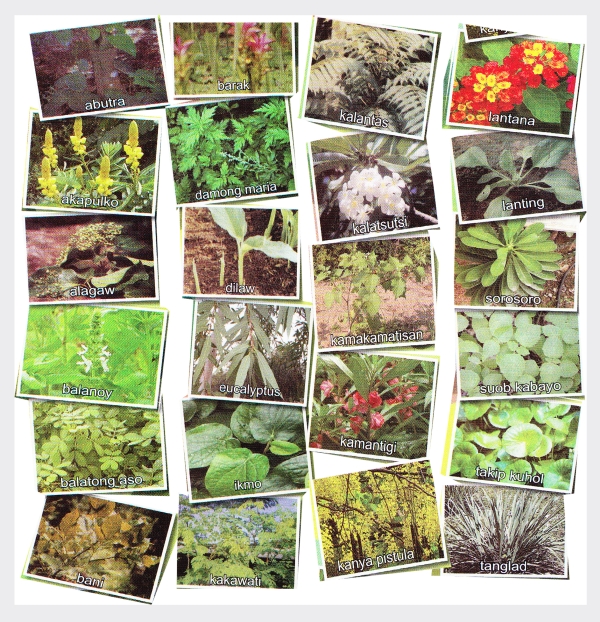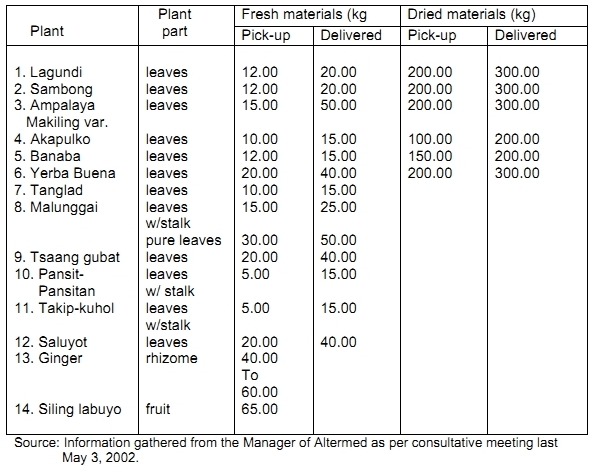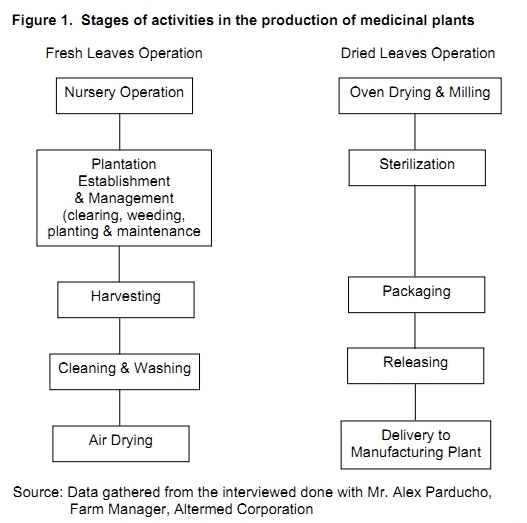Financial Viability of Medicinal Plant Farming
The integration of medicinal plant as a crop in agroforestry is a relatively new approach that is beneficial to the local people, whether they are lowland or upland farmers or most especially, the indigenous people. The Ecosystems Research and Development Bureau (ERDB) of the Department of Environment and Natural Resources (DENR) is publishing this issue on medicinal plants as a profitable farming technology to serve as a guide in the development of small backyard herbal gardens, community-based herbal plantation or urban herbal park. This can help boost the Philippine herbal industry by providing adequate supply of raw materials for local as well as global needs.

Manufactured synthetic drugs command a high price which Filipino masses oftentimes cannot buy. The passage of Republic Act No. 8423, otherwise known as “Traditional Alternative Medicine Act (TAMA)” in December 7, 1997 answers the people’s present needs on health care by providing and delivering Traditional and Alternative Health Care (PAHC) products, services and technologies that have been safe, effective, affordable and accessible for Filipinos.
As cited in the research and development work of the National Integrated Research Program on Medicinal Plants (NIRPROMP), the first medicinal plantations were established in Cavite and Davao in order to provide raw materials for the pilot plant of Bicutan in manufacturing of medicinal products. In the establishment of three herbal manufacturing plants of the Department of Health in 1985, pilot plantations of medicinal plants were also established in Cagayan, Leyte, and Cotabato.
With the growing interest on traditional herbal medicine in the country several private companies ventured into the production and manufacture of medicinal plants and products. One of the biggest in the country is the Pascual Laboratory, owner of 40 ha of medicinal plantation in Sta. Rosa, Nueva Ecija.
However, the Philippine Herbal Medicine Industry at this stage is not yet well-developed as compared with China, Japan, Korea and Vietnam. To boost the country’s medicinal industry, there is a need for a holistic paradigm shift of a small- or large-scale farming since the country has sustainable indigenous medicinal plants like ampalaya (Makiling variety), sambong, lagundi, acapulco, and many others.
The Ecosystems Research and Development Bureau (ERDB) of the Department of Environment and Natural Resources (DENR) in collaboration with the Chamber of Herbal Industry of the Philippines (CHIPI), PITAHC-DOH, other government agencies, and private sectors had shared their knowledge and workshops and exhibits on the production and management of medicinal plants. These collaborative efforts are geared to develop community-based herbal plantation in public lands or private farm lots.
These endeavors provide solution to the problem of pharmaceutical companies on the limited supply of raw materials for herbal production. At the same time, it creates livelihood options for upland dwellers and indigenous people in the countryside. Likewise, it helps increase awareness and recognition of the value of medicinal plants in rehabilitating the upland forest ecosystems. It helps promote conservation of forest biodiversity aside from serving as a potential material source of alternative medicine for people on research areas.
Marketing Aspects of Medicinal Plants and Products
Medicinal plants and products now known and used as alternative medicines in the local
market are the following:
a. Commercial available drugs from medicinal plants
Lagundi (Vitex negundo L.) As-cof, Pascual Laboratory, for cough remedy.
Sambong (Blumea balsamifera (L) DC), for diuretic relief, Pascual Laboratory
Akapulco (Cassia/Senna alta L.) lotion, for anti-fungal and skin rushes
b. Plants being developed as drugs (but available in the market as food supplements)
Ampalaya (Momordica charantia L. var. Makiling) – relief for diabetes mellitus
Ulasimang bato (Pepermia pellucida (L) HBK) – anti-hyperrurecemic
Tsaang gubat (Carmona refusa (Vahl) Masam) – anti-motility
Mutha (Cyperus pudica) – relief for malaria
Makahiya (Mimosa pudica) – relief of diarrhea
Yerba Buena (Mentha cordifolia Opoz.) – analgesic
Today many business-oriented groups have ventured into the herbal market.
Appendix 1 shows the list of some producers engaged in the manufacturing of herbal and medicinal products in the Philippines.
Financial Benefits From Medicinal Plants and Products
Herb farmers at San Jose, Dumaran, Palawan who participated in the pilot study of the Department of Health and the Palawan Center for Appropriate Rural Technology (PCART) started to cultivate lagundi (Vitex negundo) and other herbs in their small farm lot. The farmers were able to earn an extra income of P30,000 a year in lagundi farming. On the first year of operation, they obtained a small financial return but apparently in the succeeding years, the financial return increased. The socioeconomic status of the herb farmers dramatically changed. They were able to support their children through school aside from having the means to provide the basic needs of their families.
The intervention showed that medicinal crops gave them extra income rather than doing slash-and burn activities or over-harvesting of forest products. The farmers are now active in herbal farming with the goal of producing high-quality herbal raw materials on a large-scale production.
Herbal farming is a profitable business. The pharmaceutical industry demands tons of raw materials. Therefore, the entrepreneur must know the requirements of herbal farming taking into account the externalities, risks and difficulties of growing and cultivating medicinal plants. The general considerations for herbal farming are: site profiling of the farm or plantation far from pollution, soil that is free from heavy metals, high quality planting stocks to produce high quality leaves, use for organic fertilizer, and non use of insecticides, fungicides or pesticides, moisture content of dry leaves or powdered materials below 5% among others.
A study conducted by one of the professors at the University of the Philippines Los Banos, revealed that medicinal plant farming is profitable. A 1-ha area planted with lagundi or sambong produces 10,000 kg to 20,000 kg of fresh leaves at the price of P15.00/kg in 2 times harvest per year with the gross income worth P300,000 to P 600,000. Deducting the production cost, a farmer obtained a net income of about 106,000 per ha on the first year of operation. The harvest can be sold in dried and powdered forms in order to obtain higher price and profit.
Table 1 shows the price of raw materials os some medicinal plants and other high value crops.
Table 1. Prices of raw materials of some medicinal plants and other high value crops (Source: Information gathered from the Manager of Altermed as per consultative meeting last May 3, 2002)

Based on the information generated by ERDB from the pilot project on the integration of medicinal plants as agroforestry crops, the following are the projected income return per hectare of four scientifically validated medicinal plants
1. Ampalaya (Makiling variety): leaves – Year 1
No. of harvests: 48 (twice/week x 4 weeks x 3 mo. X 2 crop season) – Amount (Php) 48,000.00
Total fresh weight (kg per year): (1,000 kg/harvest)
Weight after drying (kg per year): P7,200.00 (48,000 kg x 15% recovery)
Estimated cost of production:
Cost of materials (seeds, organic Fertilizer, and pesticides, etc.): P106,200.00
Cost of labor (land preparation, clearing, Harvesting, air drying, etc.): P792,000
For drying of materials with additional cost of Oven type dryer & maintenance: P120,000.00
Gross income on fresh leaves at Php30.00/kg: P1,440,000.00
Gross income on dried leaves at Php300.00/kg: P2,160,000.00
Estimated net income on fresh leaves: P421,800.00
Estimated net income on dried leaves: P1,141,800.00
2. Sambong: leaves – Year 1
No. of harvests: 2 (six months after planting & 3 months thereafter Harvest done twice a year). Estimated cost of production Amount in (Php):
Cost of planting materials for 1 ha With spacing of 0.5 x 1.0 meters (20,000 plants/ha x Php10.00/plant): P200,000.00
Cost of labor (clearing, planting, maintenance, Harvesting 10 persons at Php250.00/day for 48 hours): P120,000.00
Cost of soil management: P5,000.00
Cost of pest management (non-use of pesticides) 10,000.00
Cost of water management: P2,000.00
Total cost of production for fresh materials: P337,000.00
Gross income for fresh leaves (Estimated harvest: 60% yield 12,000 kg/ha x Php20.00/kg of fresh leaves x 2 harvest): P480,000.00
Net income of fresh leaves: P143,000.00
In dried leaves
Additional cost of oven drying operation and management: P110,000.00
Gross income for dried leaves (Basis: yield 24,000 kg/ha/yr of fresh leaves x 15% recovery x Php300.00/kg delivered): P1,080,000.00, Less: Total cost of production for dried leaves: 447,000.00
Estimated net income on dried leaves: P633,000.00
3. Lagundi: leaves – Year 1
No. of harvests 2 (six months after planting & 3 months thereafter Harvest done twice in a year). Estimated cost of production: Amount (Php):
Cost of planting materials for one hectare with Spacing of 1.0 x 1.0 meter (10,000 plants/ha x Php10.00/plant): P100,000.00
Cost of labor (clearing, weeding, planting, maintenance and harvesting): 10 persons at Php250.00/day for 48 days): P120,000.00
Cost of soil management: P5,000.00
Cost of pest management (non-use of pesticides): P10,000.00
Cost of water management: P2,000.00
Total cost of production for fresh materials: P237,000.00
Gross income for fresh leaves (Estimated harvest: yield 10,000 kg/ha x Php20.00/kg of fresh leaves x 2 times harvest): P400,000.00
Estimated net income on fresh leaves: P163,000.00
In dried leaves
Additional cost of oven drying operation and management: P110,000.00
Gross income for dried leaves (Basis: yield 20,000 kg/ha of fresh leaves/yr x 15% recovery x Php300.00/kg delivered): P900,000.00, Less: Total cost of production for dried materials: P347,000.00
Estimated net income on dried leaves: P553,000.00
4. Acapulco: leaves – Year 1
No. of harvests 4 (four months after planting & 2 months thereafter Harvest done four x in a year) Estimated cost of production: Amount (Php):
Cost of planting materials (Php10.00/plant), Population density 3,000 plants/ha with spacing of 1.5 m x 1.0 m: P30,000.00
Cost of labor (clearing, planting, maintenance, and harvesting: 10 persons at Php250.00/day for 48 days): P120,000.00
Cost of soil management: P5,000.00
Cost of pest management: P 10,000.00
Cost of water management: P2,000.00
Total cost of production of fresh materials: P167,000.00
Additional cost if dried
Air drying + oven drying: P20,000.00
Cost of oven type dryer + maintenance: P90,000.00
Total cost of production for dried materials: P277,000.00
Gross income for fresh leaves: P400,000.00
Gross income for dried leaves (Basis: yield 40,000/kg/ha/yr fresh leaves x 15% recovery x Php100.00/kg):
Estimated net income on fresh leaves 233,000.00
Estimated net income on dried leaves 323,000.00
To summarize the production process, Figure 1 below shows the different stages of activities in the production of medicinal plants before the delivery of raw materials to the manufacturing plant. (Source: Data gathered from the interviewed done with Mr. Alex Parducho, Farm Manager, Altermed Corporation)
Using the basic information, any individual, cooperative, or corporation could venture into the herbal and medicinal products enterprise. There is a market for raw materials produced
Figure 1. Stages of activities in the production of medicinal plants

List of some producers of herbal and medicinal product in the Philippines
CHAMBER OF HERBAL INDUSTRIES OF THE PHILIPPINES, INC. (CHIPI)
LIST OF MEMBERS
As of January 2012
REGULAR MEMBERS
1 ABS GEN HERBS
2 AKITA HERBAL PRODUCTS
3 ALDRTZ CORPORATION
4 ALLIED EXPRESS INTERNATIONAL IMPORT EXPORT INC.
5 AMCHEM
6 AZTEC FOODGROWERS CORPORATION
7 BEAULIFE ENTERPRISE
8 BETTERHERBS CORPORATION
9 BIO ESSENCE FACIAL SLIMMING CENTER
10 BIOLOGICAL HOMEOPATHIC MEDICAL CORP. – CEBU
11 BIOMART ASIA
12 CAPSUGEL
13 CHEMWORLD MARKETING CORP.
14 CONNEL BROS. CO. PILIPINAS, INC.
15 CRD HERBAL PRODUCTS INCORPORATED
16 DAILA HERBAL COMMUNITY ENTERPRISE INC.
17 DAVENBEN ENTERPRISES CORPORATION
18 DKSH PHILIPPINES, INC.
19 DMI MEDICAL SUPPLY CO., INC.
20 DON ANDREYS HERBAL MARKETING
21 ECARMA HEALTH OPTIONS
22 E. L LABORATORIES, INC.
23 EMPOWER MARKETING, INC.
24 ESSENTIAL INGREDIENTS SPECIALIST PROVIDER, INC.
25 EUNICE INCORPORATED
26 EUROCHEMICALS INC.
27 FIRST VITA PLUS MARKETING CORP.
28 GLOBAL HABITZ CO., LTD
29 GLOBAL PARTNERS, INC
30 GLORIOUS INDUSTRIAL AND DEV’T. CORP.
31 GOLDLOOK EGP MANUFACTURING, INC.
32 GOLDSHINE PHARMACEUTICALS
33 GOLDWARE ESSENTIALS PRODUCTS CORPORATION
34 HERBANEXT INCORPORATED
35 HERBCARE CORPORATION
36 HERBS AND NATURE CORPORATION
37 HOTEL AND SPA ESSENTIALS, INC.
38 INTERNATIONAL PHARMACEUTICALS, INC.
39 LIFE PURE WELLNESS CENTER
40 MACROPHARMA CORPORATION
41 MANILA NATURES LINK CORP.
42 MIYO PRODUCTS RESOURCES INC.
43 MLGS HERBAL PRODUCTS
44 MOORINGA GREEN GOLD CORPORATION
45 NATTURAL QUALITY CORPORATION
46 NEGROS ISLAND SUSTAINABLE AGRICULTURE AND RURAL DEVELOPMENT (NISARD)
47 NEW MARKETLINK PHARMACEUTICAL CORP.
48 NORTHFIELD LABORATORIES, INC
49 NUTRAMEDICA, INC.
50 OKALA QUALITY RESEARCH AND DEVELOPMENT ENT. (SUSIES NATURAL)
51 ORGANICA NUTRACEUTICALS, INC
52 P. SUZARA HERBAL PRODUCTS
53 PALAWAN CENTER FOR APPROPRIATE RURAL TECHNOLOGY
54 PASCUAL LABORATORIES
55 PERVIL COSMETICS PHILS., INC.
56 PHILIPPINE MORINDA CITRIFOLIA INC.
57 PRIMERA GLOBAL, INC.
58 PROSOURCE INTERNATIONAL INC.
59 PSALMSTRE ENTERPRISES
60 RAINIERS RESEARCH AND DEVELOPMENT INSTITUTE, INC
61 RCC AMAZING TOUCH INTERNATIONAL INC.
62 REFINETTE COSMETIC INDUSTRY
63 RITA RITZ BAKEHOUSE
64 RLN MALUNGGAY HERB TEA MANUFACTURING
65 SCORT PHARMACEUTICALS
66 SENTRO SA PAGSUSURI, PAGSASANAY AT PANGASIWANG PANG-AGHAM AT TEKNOLOHIYA CORP.
67 SK LABORATORIES, INC.
68 SNI PHILIPPINES, INC.
69 SOL Y VIENTO PHYTO THERAPY
70 SPEM HEALTH CARE CENTER
71 SPLASH CORPORATION
72 STO. NIÑO BOTANICALS
73 TOTAL NUTRITION CORP.
74 UNIHERB CORPORATION
75 WAGEMARK CORPORATION
76 WHEALTH, INC.
77 YSA
ASSOCIATE MEMBER:
1 GDL CAPSULE PHILS., INC.
INDUSTRIAL MEMBERS:
1 ARNICHEM CORPORATION
2 IQ PACKAGING SYSTEMS, INC.
Contact Information
Address:
Chamber of Herbal Industries of the Phlippines Secretariat:
Mezzanine Flr., Strata 300 Bldg. P. Guevarra Street San Juan 1500 Philippines
Landlines:
(63 2) 907-8536 LLM/ (02) 584-6241
FAX:
(63 2) 725-6470
Email: [email protected]
Source: RESEARCH INFORMATION SERIES ON ECOSYSTEMS
Volume 15 No. 1
January – April 2003
Financial Viability of Medicinal Plant Farming
Compiled by Aurora S. Jose


I recently discovered AllMachines and found it really helpful for learning about different types of equipment. Their section on Loaders is detailed and easy to understand. I also checked out the Excavators page, which covers a range of uses for farm and construction work. For anyone comparing brands, their dedicated pages for Bobcat Excavators and Case Excavators are worth a look.
Awesome post! If anyone’s on the search for great custom app development in Dubai, check us out—we’d love to help turn your ideas into reality!
Hey, thanks for sharing this process of How to Make Money in Medicinal Plant Farming. With us .keep sharing with us ,.